In recent days, the online design and development community has been abuzz with controversy surrounding a drastic price increase implemented by Webflow, a popular web design platform. This uproar has been particularly visible on Twitter, where numerous users have shared their frustration and disbelief over the changes. Here, we examine the key aspects of this drama, the reactions from the community, and the responses from Webflow and other entities.
The controversy began with a tweet from a user named Nico Cer***** (Failory.com), who expressed his shock at Webflow’s sudden price hike. He claimed that Webflow was increasing his annual fee from $468 to $15,000, a 32-fold increase, and had given him just one week to decide whether to upgrade or migrate his entire site to another CMS.
This tweet quickly garnered attention, sparking a wave of reactions from other users who shared similar sentiments or offered solutions. The response from the Twitter community was swift and varied. Many users criticized Webflow’s pricing structure and expressed distrust towards the company.

Offers of assistance
Many Twitter users have echoed these sentiments, emphasizing the drawbacks of relying on SaaS platforms and the advantages of self-hosting. For instance, Dennis (@d3layd) pointed out the benefits of WordPress, a self-hosted solution, saying, “I’d love to help you migrate to WordPress. I understand it can be a lot but with WordPress, you own your code and you can move around from host to host as you see fit“. This highlights the peace of mind and flexibility that comes with owning your technology stack, something that is becoming increasingly appealing in the face of unpredictable SaaS pricing models.
In light of the situation, many users and professionals extended offers to help Nico and others affected by the price hike to migrate to alternative platforms, particularly WordPress. Moreover, the behavior of Webflow in this scenario has also been criticized for its lack of transparency and fair dealing. Nico Cerdeira, the founder of Failory, highlighted this issue in his tweets, stating, “I’ve already asked 5 times to the sales rep to share pricing and timeline details over email. She said, ‘No because you’ll tweet about it‘”.
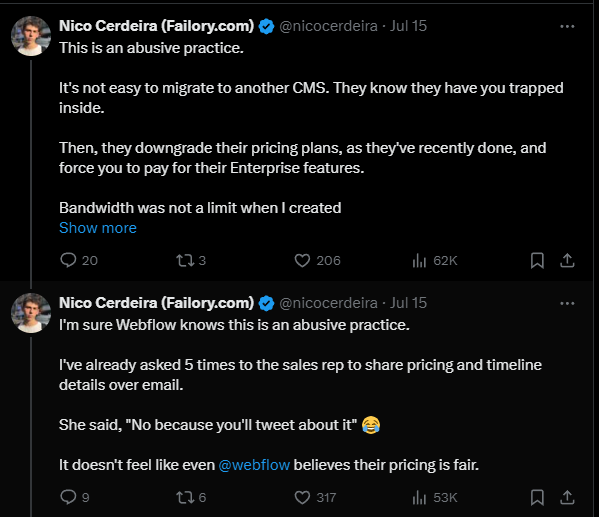
This comment underlines a troubling aspect of the relationship between users and SaaS providers: the lack of open communication and the potential for users to feel trapped or manipulated. The unwillingness to provide clear information suggests that even Webflow may recognize the unfairness of their pricing strategy, further eroding trust among its user base.
Criticisms and alternatives

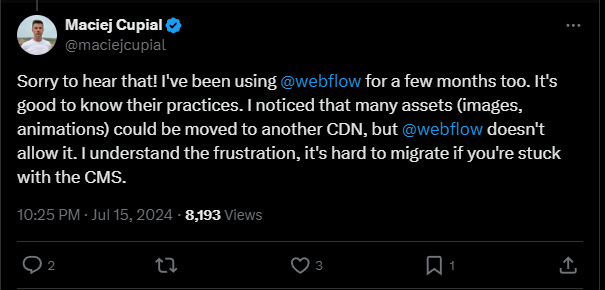

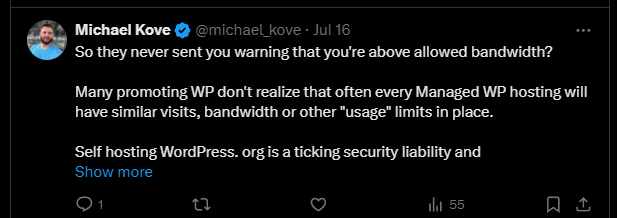
Webflow’s response and resolution
In response to the uproar, Webflow reiterated that existing plans would maintain their current limits. However, this assurance did little to quell the dissatisfaction among users. In response to the growing backlash, Webflow representatives reached out to Nico Cer***** to address the issues. Webflow assured Nico that the company was committed to resolving the matter and was willing to discuss the situation further. They mentioned that Webflow valued the sites hosted on their platform and was eager to retain their business by offering support.
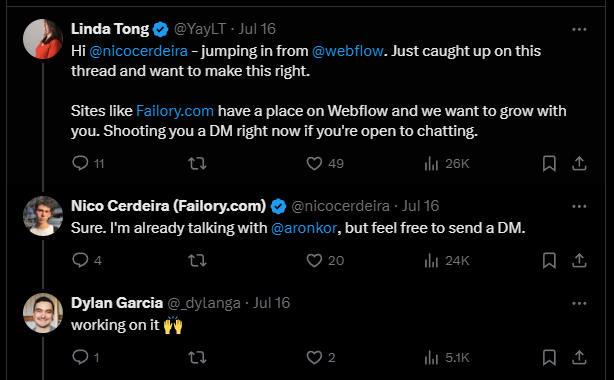
Furthermore, Dylan Ga**** from Webflow worked directly with Nico to implement technical changes aimed at reducing bandwidth usage, a key factor contributing to the high costs. Dylan suggested republishing the site after adjusting the settings to lower bandwidth consumption, which showed promising results.
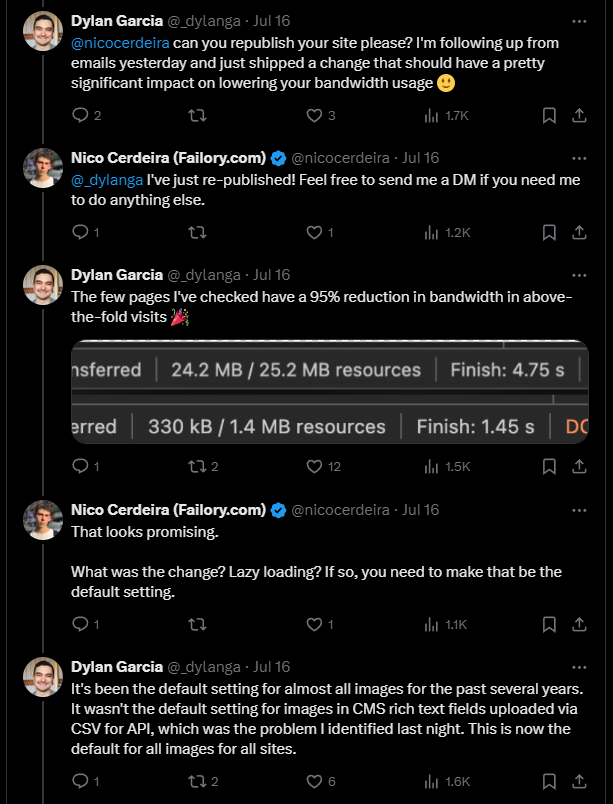
Nico confirmed that these changes made a significant difference, indicating that the immediate crisis was alleviated. However, the incident prompted many, including Nico, to reconsider the long-term viability of staying with Webflow given the unpredictable nature of SaaS pricing.
“Glad you seem to have gotten this sorted but you might want to use the reprieve to give yourself time to transition to WordPress. That way in future if your hosting company tries to play games you can give them the finger and move your website in as little time as it takes.” – Kris Roadruck (@KrisRoadruck)
This episode serves as a cautionary tale about the importance of control and ownership in web hosting, reminding users of the potential pitfalls of relying heavily on SaaS platforms and the value of self-hosting solutions.
Ownership and control in the world of SaaS
The Webflow pricing drama brings to light a fundamental issue inherent in relying on SaaS (Software as a Service) platforms: the lack of true ownership and control. When using SaaS services, users essentially rent the technology and infrastructure from a provider, which means that crucial aspects of their online presence are subject to the provider’s policies, pricing structures, and business decisions. This dependency can be particularly problematic when unexpected changes, such as sudden price hikes, occur. Users are left with limited recourse and must either comply with the new terms or undergo the often arduous process of migrating their sites to another platform. This situation underscores the vulnerability of being too reliant on external service providers for critical business operations.
For large-scale projects, especially those with significant traffic and complex requirements, it may be prudent to consider more traditional hosting solutions such as shared hosting, Virtual Private Servers (VPS), or dedicated servers. These options offer greater control and ownership over the website and its underlying technology. By managing their own hosting environments, businesses can tailor their infrastructure to meet specific needs, implement custom security measures, and avoid unexpected cost increases imposed by third-party providers. Additionally, using open-source technologies and self-hosted solutions allows for more flexibility and scalability, enabling businesses to grow and adapt without being constrained by the limitations of a SaaS platform. While self-hosting requires more technical expertise and resources, the long-term benefits of autonomy, cost predictability, and full control over the website can significantly outweigh the initial investment and operational efforts.
Many Twitter users have echoed these sentiments, emphasizing the drawbacks of relying on SaaS platforms and the advantages of self-hosting. For instance, Dennis (@d3layd) pointed out the benefits of WordPress, a self-hosted solution, saying, “I’d love to help you migrate to WordPress. I understand it can be a lot but with WordPress, you own your code and you can move around from host to host as you see fit“. This highlights the peace of mind and flexibility that comes with owning your technology stack, something that is becoming increasingly appealing in the face of unpredictable SaaS pricing models.
This highlights the critical role of user feedback and the importance of advocating for fair practices in the SaaS industry.
Kamil Kołosowski
Author of this post.
